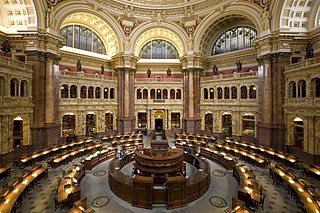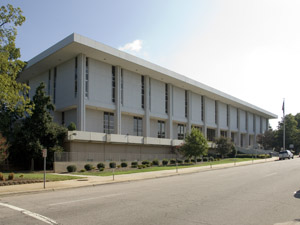Related Research Articles

Digitization is the process of converting information into a digital format. The result is the representation of an object, image, sound, document, or signal obtained by generating a series of numbers that describe a discrete set of points or samples. The result is called digital representation or, more specifically, a digital image, for the object, and digital form, for the signal. In modern practice, the digitized data is in the form of binary numbers, which facilitates processing by digital computers and other operations, but digitizing simply means "the conversion of analog source material into a numerical format"; the decimal or any other number system can be used instead.

A research library is a library that contains an in-depth collection of material on one or several subjects. A research library will generally include an in-depth selection of materials on a particular topic or set of topics and contain primary sources as well as secondary sources. Research libraries are established to meet research needs and, as such, are stocked with authentic materials with quality content. Research libraries are typically attached to academic or research institutions that specialize in that topic and serve members of that institution. Large university libraries are considered research libraries, and often contain many specialized branch research libraries. The libraries provide research materials for students and staff of these organizations to use and can also publish and carry literature produced by these institutions and make them available to others. Research libraries could also be accessible to members of the public who wish to gain in-depth knowledge on that particular topic.
In library and archival science, digital preservation is a formal endeavor to ensure that digital information of continuing value remains accessible and usable. It involves planning, resource allocation, and application of preservation methods and technologies, and it combines policies, strategies and actions to ensure access to reformatted and "born-digital" content, regardless of the challenges of media failure and technological change. The goal of digital preservation is the accurate rendering of authenticated content over time. The Association for Library Collections and Technical Services Preservation and Reformatting Section of the American Library Association, defined digital preservation as combination of "policies, strategies and actions that ensure access to digital content over time." According to the Harrod's Librarian Glossary, digital preservation is the method of keeping digital material alive so that they remain usable as technological advances render original hardware and software specification obsolete.
Artstor is a nonprofit organization that builds and distributes the Digital Library, an online resource of more than 2.5 million images in the arts, architecture, humanities, and sciences, and Shared Shelf, a Web-based cataloging and image management software service that allows institutions to catalog, edit, store, and share local collections.
The Open Content Alliance (OCA) was a consortium of organizations contributing to a permanent, publicly accessible archive of digitized texts. Its creation was announced in October 2005 by Yahoo!, the Internet Archive, the University of California, the University of Toronto and others. Scanning for the Open Content Alliance was administered by the Internet Archive, which also provided permanent storage and access through its website.

Google Books is a service from Google that searches the full text of books and magazines that Google has scanned, converted to text using optical character recognition (OCR), and stored in its digital database. Books are provided either by publishers and authors through the Google Books Partner Program, or by Google's library partners through the Library Project. Additionally, Google has partnered with a number of magazine publishers to digitize their archives.
The California Digital Library (CDL) was founded by the University of California in 1997. Under the leadership of then UC President Richard C. Atkinson, the CDL's original mission was to forge a better system for scholarly information management and improved support for teaching and research. In collaboration with the ten University of California Libraries and other partners, CDL assembled one of the world's largest digital research libraries. CDL facilitates the licensing of online materials and develops shared services used throughout the UC system. Building on the foundations of the Melvyl Catalog, CDL has developed one of the largest online library catalogs in the country and works in partnership with the UC campuses to bring the treasures of California's libraries, museums, and cultural heritage organizations to the world. CDL continues to explore how services such as digital curation, scholarly publishing, archiving and preservation support research throughout the information lifecycle.
The National Digital Information Infrastructure and Preservation Program (NDIIPP) of the United States was an archival program led by the Library of Congress to archive and provide access to digital resources. The program convened several working groups, administered grant projects, and disseminated information about digital preservation issues. The U.S. Congress established the program in 2000, and official activity specific to NDIIPP itself wound down between 2016 and 2018. The Library was chosen because of its role as one of the leading providers of high-quality content on the Internet. The Library of Congress has formed a national network of partners dedicated to preserving specific types of digital content that is at risk of loss.
Hunter Library is the university library at Western Carolina University and is located in Cullowhee, North Carolina. Hunter Library supports Western Carolina University's mission of teaching and learning. The Library provides intellectual content, and services related to its discovery and use, for the learning, teaching, and research activities of the University's students, faculty, and staff. By supporting the acquisition of learning and the production of knowledge and scholarship, Hunter Library intends to inspire the individual and the intellect, fostering professional, personal and social growth.

Book scanning or book digitization is the process of converting physical books and magazines into digital media such as images, electronic text, or electronic books (e-books) by using an image scanner. Large scale book scanning projects have made many books available online.

The State Library of North Carolina is an institution which serves North Carolina libraries, state government employees, genealogists, and the citizens of North Carolina. The library is the main depository for North Carolina state publications and serves the needs of North Carolina government agencies and state government employees by providing access to information resources that are vital to public decision-making and economic development.

In conservation, library and archival science, preservation is a set of preventive conservation activities aimed at prolonging the life of a record, book, or object while making as few changes as possible. Preservation activities vary widely and may include monitoring the condition of items, maintaining the temperature and humidity in collection storage areas, writing a plan in case of emergencies, digitizing items, writing relevant metadata, and increasing accessibility. Preservation, in this definition, is practiced in a library or an archive by a conservator, librarian, archivist, or other professional when they perceive a collection or record is in need of maintenance.
Chronicling America is an open access, open source newspaper database and companion website. It is produced by the United States National Digital Newspaper Program (NDNP), a partnership between the Library of Congress and the National Endowment for the Humanities. The NDNP was founded in 2005. The Chronicling America website was publicly launched in March 2007. It is hosted by the Library of Congress. Much of the content hosted on Chronicling America is in the public domain.
A digital library, also called an online library, an internet library, a digital repository, a library without walls, or a digital collection is an online database of digital objects that can include text, still images, audio, video, digital documents, or other digital media formats or a library accessible through the internet. Objects can consist of digitized content like print or photographs, as well as originally produced digital content like word processor files or social media posts. In addition to storing content, digital libraries provide means for organizing, searching, and retrieving the content contained in the collection. Digital libraries can vary immensely in size and scope, and can be maintained by individuals or organizations. The digital content may be stored locally, or accessed remotely via computer networks. These information retrieval systems are able to exchange information with each other through interoperability and sustainability.

Smithsonian Libraries and Archives is an institutional archives and library system comprising 21 branch libraries serving the various Smithsonian Institution museums and research centers. The Libraries and Archives serve Smithsonian Institution staff as well as the scholarly community and general public with information and reference support. Its collections number nearly 3 million volumes including 50,000 rare books and manuscripts.

The Digital Public Library of America (DPLA) is a US project aimed at providing public access to digital holdings in order to create a large-scale public digital library. It officially launched on April 18, 2013, after two-and-a-half years of development.
The Mountain West Digital Library (MWDL) is a centralized discovery portal for digital resources from libraries, archives, museums, government agencies, and historical societies in the Mountain West region of the United States. MWDL aggregates metadata from these memory institutions and provides online access to their cultural heritage and scholarly resources at http://mwdl.org. The MWDL provides services to a widespread digital library community and serves as the regional service hub to the Digital Public Library of America for Utah, Nevada, Idaho, Arizona, Montana, and Hawaii.

The State Archives of North Carolina, officially the North Carolina Division of Archives and Records, is a division of North Carolina state government responsible for collecting, preserving, and providing public access to historically significant archival materials relating to North Carolina, and responsible for providing guidance on the preservation and management of public government records to state, county, city and state university officials. First founded as the North Carolina Historical Commission in 1903, the State Archives has undergone multiple changes in organization, title, and relation to other state agencies. Since May 2012, it has been known as the Division of Archives and Records within the North Carolina Department of Natural & Cultural Resources' Office of Archives and History.
Digital heritage is the use of digital media in the service of understanding and preserving cultural or natural heritage.

Saving Ukrainian Cultural Heritage Online (SUCHO) is a web archiving initiative of over 1,500 international volunteers who are collaborating online to digitize and preserve Ukrainian cultural heritage. The effort launched on March 1, 2022, in response to the Russian invasion of Ukraine in order to back up and preserve potentially endangered data and technology of Ukraine's cultural institutions. The efforts have been compared to those of the Monuments Men during World War II.
References
- ↑ "North Carolina ECHO: Exploring Cultural Heritage Online. Välja hotell & boende i Budapest". www.hotellbudapest.net.
- ↑ "Home - Winnebago Industries". Home.
- ↑ "June update from John Palfrey on The Digital Public Library of America". Harvard Steering Committee. Retrieved 2011-07-01.